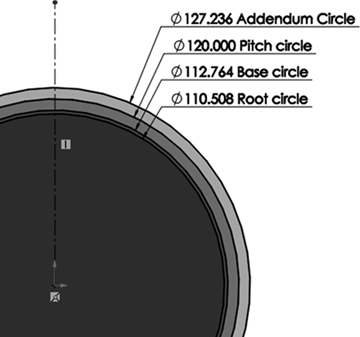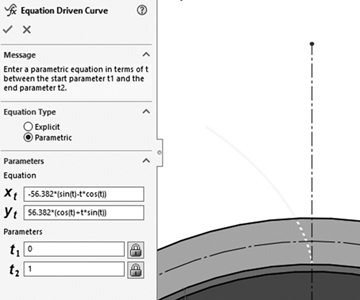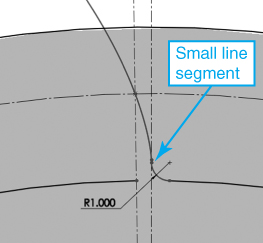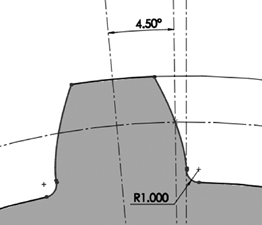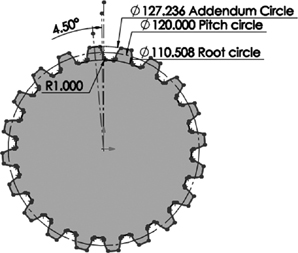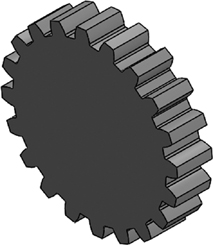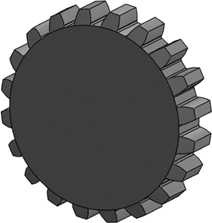4.3 Spur Gears
Gears are an important and essential mechanical element in mechanical design. A wide range of products and applications use gears. There are various types of gears: spur, helical, bevel, spiral, worm, planetary, and rack and pinion, to name a few. A spur gear is the simplest type of gear and the type we cover here. Typical mechanical design courses in colleges cover the principles and design of gears. In this section, we cover spur gears from a CAD point of view (i.e., how we construct a gear once it is designed). While gears are standard elements that can be purchased off the shelf (they can also be inserted from the SolidWorks Toolbox into a part or assembly file), it is important to learn how to create a gear feature in a CAD/CAM system.
A gear tooth is the intricate part of a gear. Figure 4.3 shows two meshing gears. Figure 4.4A shows the conjugate line and pressure angle. Figure 4.4B shows the involute profile. Gearing and gear meshing ensure that two disks (the two gears) in contact roll against one another without slipping.
Moreover, the gear teeth should not interfere with the uniform rotation that one gear would induce in the other—a requirement known as the conjugate action. The conjugate action also ensures that the perpendicular line to a tooth profile at its point of contact with a tooth from the other gear always passes through a fixed point on the centerline connecting the centers of the two meshing gears. Figure 4.4A shows the conjugate line. The conjugate line is also known as the line of force because the driving force from the driving gear (driver) is transmitted in the direction of this line to the other gear (driven). The angle between the perpendicular radius to the conjugate line and the centerline is always constant for two meshing gears. This angle is known as the pressure angle and is shown as the angle ø in Figure 4.4A.

Figure 4.3 Meshing gears
The key to successful functional gears is the conjugate action. While various profiles can produce conjugate action, the involute profile is the best because it allows for imperfections in gear manufacturing and yet maintains the conjugate action. The imperfection may produce a slightly different distance between the two shafts of the gears from the designed value. Figure 4.4B shows how the shape of the involute profile is generated. An involute is defined as the path of the endpoint of a cord when it is pulled straight (held taut) and unwrapped from a circular disk, as shown in Figure 4.4B. The involute geometry ensures that a constant rotational speed of the driving gear produces a constant rotational speed in the driven gear. For spur gears, the teeth are cut perpendicular to the plane of the gear, where the involute profile resides.
The creation of a gear CAD model requires two basic concepts: knowledge of the gear geometry and the involute equation. The geometry is shown in Figure 4.3. The base circle is the circle where the involute profile begins. The pitch circle defines the contact (pitch) point between the two gears (see Figure 4.4A). The dedendum circle is usually the same as the base circle, as can be concluded from Figure 4.4A (dedendum d = rp – rb). The addendum circle is the circle that defines the top of the tooth as shown in Figure 4.4C (addendum a = ra – rp, where ra is the addendum circle radius). Typically, the addendum and the dedendum are equal. In such case, the pitch and base circle sizes determine the values for both. The root circle is smaller than the base circle to allow cutting the tooth during manufacturing. The tooth profile between the base and root circles is not an involute. It could be any geometry, such as line.

Figure 4.4 Details of a gear tooth
The creation of a gear CAD model requires two steps: Calculate the tooth angle α and the tooth involute profile. While many books on mechanical engineering design offer extensive in-depth coverage of gear analysis, we offer a simplified but accurate version that enables us to create a CAD model of the gear. We begin with the definition of circular pitch. As shown in Figure 4.4C, the circular pitch, pc, is defined as the distance along the pitch circle between corresponding points on adjacent teeth. As shown in Figure 4.4C, we use pc as the circular pitch of the gear, rp as the pitch circle radius, and α as the tooth angle. Using these variables, we can write:

where dp = 2rp is the pitch circle diameter and N is the number of gear teeth. From the tooth geometry shown in Figure 4.4C, we can write:

Substituting pc from Eq. (4.2) into Eq. (4.1) and reducing gives:

The derivation of the involute equation is more complex and is not covered here. We align the involute of one tooth with the XY coordinate system as shown in Figure 4.4D, where the lowest point Pb on the involute lies on the Y axis. This orientation does not represent a limitation but rather simplifies the form of the involute equation, which is therefore given by:

where rb (the base circle radius) is given by (see Figure 4.4A):

and (x, y) are the coordinates of any point P on the involute at an angle θ, as shown in Figure 4.4D. The lowest point Pb on the involute corresponds to the value of θ = 0 and lies on the base circle. Point Pa lies on the addendum circle and does not necessarily correspond to the value of θ = θmax. We can arbitrarily select a large enough value for θmax so that the involute crosses the addendum circle and then trim it to that circle. Therefore, we create the involute profile by generating points on it using Eq. (4.4) and connecting them with a spline curve, or we input Eq. (4.4) into a CAD/CAM system.
The root circle is always less than the base circle. For simplicity, we have the root circle radius, rr, be 0.98 of the base circle radius. (There are other formulas that do not give consistent results.) Thus, we write:

The following steps summarize the calculations we need to create a gear CAD model:
The input parameters we need are the pitch circle radius rp, the pressure angle Ø, and the gear number of teeth N.
Calculate rb using Eq. (4.5).
Calculate rr using Eq. (4.6).
Calculate the gear dedendum d = rp – rb.
Assuming that the addendum and dedendum are equal, calculate the addendum circle radius as ra = rp + a = rp + d (see Figures 4.4C and 4.4D).
Use Eq. (4.3) to calculate the tooth angle α.
Enter the involute parametric equation given by Eq. (4.4) into a CAD/CAM system to sketch the involute curve as a spline.
Create one gear tooth and use a sketch circular pattern to pattern it to create all gear teeth.

